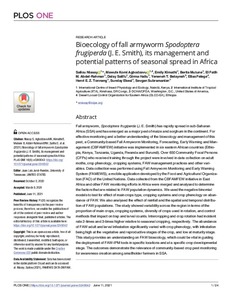| dc.contributor.author | Niassy, S. |
| dc.contributor.author | Agbodzavu, K.M. |
| dc.contributor.author | Kimathi, E.K. |
| dc.contributor.author | Mutune, B. |
| dc.contributor.author | Abdel-Rahman, E.M. |
| dc.contributor.author | Salifu, D. |
| dc.contributor.author | Hailu, G. |
| dc.contributor.author | Belayneh, Y.T. |
| dc.contributor.author | Felege, E. |
| dc.contributor.author | Tonnang, H. |
| dc.contributor.author | Ekesi, S. |
| dc.contributor.author | Subramanian, S. |
| dc.date.accessioned | 2021-07-08T14:52:21Z |
| dc.date.available | 2021-07-08T14:52:21Z |
| dc.date.issued | 2021 |
| dc.identifier.citation | Niassy, S., Agbodzavu, K.M., Kimathi, E., Mutune, B., Abdel-Rahman, E.M., Salifu, D., ... & Subramanian, S. (2021). Bioecology of fall armyworm Spodoptera frugiperda (J. E. Smith), its management and potential patterns of seasonal spread in Africa. PLOS ONE, 16(6), e0249042: 1-24. |
| dc.identifier.issn | 1932-6203 |
| dc.identifier.uri | https://hdl.handle.net/20.500.12478/7167 |
| dc.description.abstract | Fall armyworm, Spodoptera frugiperda (J. E. Smith) has rapidly spread in sub-Saharan Africa (SSA) and has emerged as a major pest of maize and sorghum in the continent. For effective monitoring and a better understanding of the bioecology and management of this pest, a Community-based Fall Armyworm Monitoring, Forecasting, Early Warning and Management (CBFAMFEW) initiative was implemented in six eastern African countries (Ethiopia, Kenya, Tanzania, Uganda, Rwanda and Burundi). Over 650 Community Focal Persons (CFPs) who received training through the project were involved in data collection on adult moths, crop phenology, cropping systems, FAW management practices and other variables. Data collection was performed using Fall Armyworm Monitoring and Early Warning System (FAMEWS), a mobile application developed by the Food and Agricultural Organization (FAO) of the United Nations. Data collected from the CBFAMFEW initiative in East Africa and other FAW monitoring efforts in Africa were merged and analysed to determine the factors that are related to FAW population dynamics. We used the negative binomial models to test for effect of main crops type, cropping systems and crop phenology on abundance of FAW. We also analysed the effect of rainfall and the spatial and temporal distribution of FAW populations. The study showed variability across the region in terms of the proportion of main crops, cropping systems, diversity of crops used in rotation, and control methods that impact on trap and larval counts. Intercropping and crop rotation had incident rate 2-times and 3-times higher relative to seasonal cropping, respectively. The abundance of FAW adult and larval infestation significantly varied with crop phenology, with infestation being high at the vegetative and reproductive stages of the crop, and low at maturity stage. This study provides an understanding on FAW bioecology, which could be vital in guiding the deployment of FAW-IPM tools in specific locations and at a specific crop developmental stage. The outcomes demonstrate the relevance of community-based crop pest monitoring for awareness creation among smallholder farmers in SSA. |
| dc.format.extent | 1-24 |
| dc.language.iso | en |
| dc.subject | Spodoptera Frugiperda |
| dc.subject | Subsaharan Africa |
| dc.subject | Pests of Plants |
| dc.subject | Maize |
| dc.subject | Intercropping |
| dc.subject | Cropping Systems |
| dc.subject | East Africa |
| dc.title | Bioecology of fall armyworm Spodoptera frugiperda (J. E. Smith), its management and potential patterns of seasonal spread in Africa |
| dc.type | Journal Article |
| cg.contributor.affiliation | International Centre of Insect Physiology and Ecology |
| cg.contributor.affiliation | International Institute of Tropical Agriculture |
| cg.contributor.affiliation | DCHA/OFDA, United States of America |
| cg.contributor.affiliation | Desert Locust Control Organization for Eastern Africa, Ethiopia |
| cg.coverage.region | Africa |
| cg.coverage.region | East Africa |
| cg.coverage.country | Burundi |
| cg.coverage.country | Ethiopia |
| cg.coverage.country | Kenya |
| cg.coverage.country | Rwanda |
| cg.coverage.country | Tanzania |
| cg.coverage.country | Uganda |
| cg.coverage.hub | Eastern Africa Hub |
| cg.identifier.bibtexciteid | NIASSY:2021 |
| cg.isijournal | ISI Journal |
| cg.authorship.types | CGIAR and developing country institute |
| cg.iitasubject | Agronomy |
| cg.iitasubject | Crop Systems |
| cg.iitasubject | Farming Systems |
| cg.iitasubject | Maize |
| cg.iitasubject | Pests of Plants |
| cg.iitasubject | Plant Breeding |
| cg.iitasubject | Plant Health |
| cg.iitasubject | Plant Production |
| cg.journal | PLOS ONE |
| cg.notes | Open Access Journal; Published online: 11 June 2021 |
| cg.accessibilitystatus | Open Access |
| cg.reviewstatus | Peer Review |
| cg.usagerightslicense | Creative Commons Attribution 4.0 (CC BY 0.0) |
| cg.targetaudience | Scientists |
| cg.identifier.doi | https://dx.doi.org/10.1371/journal.pone.0249042 |
| cg.iitaauthor.identifier | Mawufe Agbodzavu: 0000-0001-5435-1250 |
| cg.futureupdate.required | No |
| cg.identifier.issue | 6: e0249042 |
| cg.identifier.volume | 16 |

